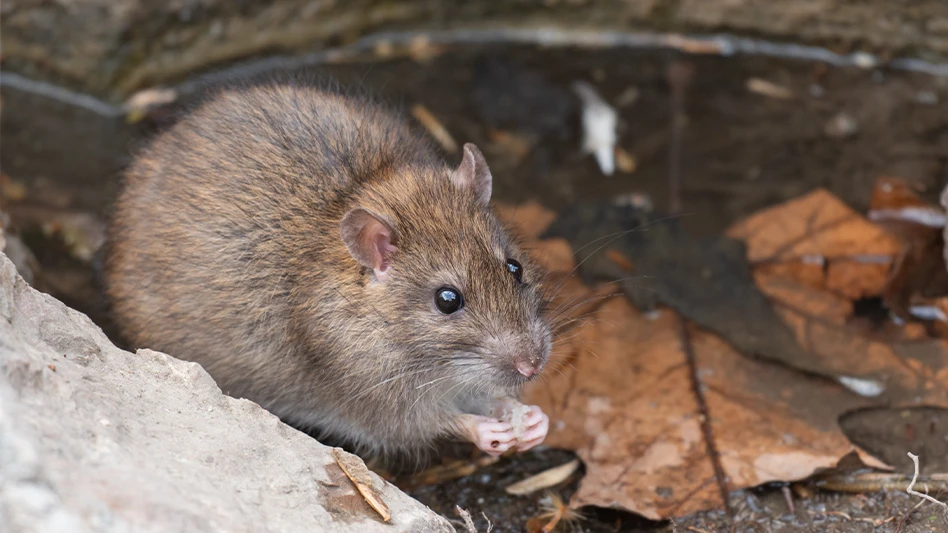
iStock | MriyaWildlife
Editor’s Note: The following article was adapted from Techletter, with permission from Pinto & Associates.
Mouse fact No. 1: Mice are territorial and rarely travel more than 30 feet from their nest. If food is nearby, a mouse often remains within a 10 foot radius of the nest. Mice are good climbers so they can be living above their main food source in suspended ceilings, in attic spaces, or in vertical pipe runs. Or, they may be living below in floor voids, crawl spaces, storage rooms, or under equipment.
Control tip No. 1: When you find evidence of mice feeding, imagine a 3-dimensional sphere radiating out 10 feet in each direction from from the food source in the center. Inspect the entire area - sideways, above, and below. If you don't find evidence of mice, expand the radius of the sphere and your inspection to 30 feet. Harborage sites will be within this area, which will include the floors directly above and below, and may even include outdoor areas.
Knowing the travel range of mice also gives you clues as to how many mice you're dealing with. If you're finding evidence of mice on different floors or in different sections of a building, you're probably not dealing with foraging mice from a single colony. Instead, you have many small, separate colonies... And lots of mice. You will have to bait or trap each colony separately.
Mouse fact No. 2: Mice travel along well-defined runways especially in dark, protected areas. They like to travel where they can feel their whiskers touching a surface so they prefer to move along the intersections of walls and floors, and they especially like corners. But they are perfectly comfortable using vertical runways along pipes or utility lines to travel between floors as well.
Control tip No. 2: To find runways, look for rubmarks along baseboards, beams, pipes, and other suspected travel routes. You may also see footprints or tail drag marks in dusty areas. You can leave a tracking patch by placing a thin layer of talc or a nontoxic dust; then check back for footprints. Place traps, glue boards, or baits not only at feeding sites, but along runways, in a line between suspected nest sites and food sources. In mouse runways, place baits or traps about 10 feet apart (closer in heavier infestations) against walls and in corners whenever possible.
Mouse fact No. 3: Mice are curious and will investigate changes in their territory. They dart from place to place during their evening territorial rounds, covering the same route, over and over again. They rely more on their "kinesthetic" sense, which is a subconscious recording of a series of movements necessary to go from point A to point B, rather than on their eyes, ears, and nose. When something is moved or changed in their territory, it's a crisis. They slowly re-explore their territory, investigating every object, new or old, learning a new route.
Control tip No. 3: Disturb the environment of mice periodically by moving pallets, boxes, shelves, etc. This forces the mice to investigate their changed territory and means that they are more likely to come across your traps, glue boards, or bait. When you revisit an account, any traps or bait placements that don't show activity should be moved to take advantage of a mouse's natural curiosity to investigate new things in his territory. An active stock rotation policy in warehouses, food plants, and restaurants will have a similar effect.
Mouse fact No. 4: Mice are nibblers. They might eat 20 or more times during their evening rounds, but will eat very little at most stops. However, they usually do have one or two favorite feeding sites within their territory. These are dark, protected sites with their favorite foods and in these sites they will eat more than at their other stops. In these feeding sites you will find spilled food, lots of mouse droppings, and you'll notice a strong "mousey" odor.
Control tip No. 4: Make lots of small bait placements, rather than a few large ones, but also concentrate your baiting in the favored feeding sites. The runways leading to these feeding sites are good places to set snap traps and glue boards. The favorite foods that the mice are feeding on here are usually your best choices for baiting traps.
The authors are co-owners of Pinto & Associates.
Latest from Pest Control Technology
- Built-by-Owner Home? Look for Surprises
- The Pest Rangers Acquires O.C.E. Pest & Termite Control
- The Professional Pest Management Alliance Expands Investor Network
- Big Blue Bug Solutions’ Holiday Lighting Event Sets New Viewership Record
- Beyond the Pest | Ep. 6 – Jeff Weier
- Fleetio Appoints Leslie Henthorn as CMO
- Rose Pest Solutions Donates Clothing to U.S. Veterans
- Florida Pest Management Association Announces 2026 Business & Operations EXPO





